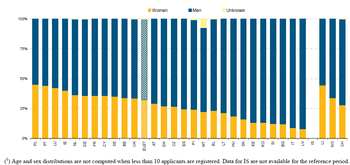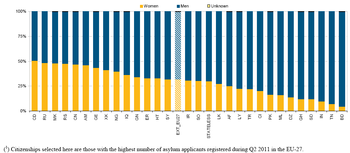Archive:Asylum quarterly report
- Data from December 2011. Most recent data: Further Eurostat information, Main tables and Database.



Asylum applicants and first instance decisions on asylum applications: second quarter 2011
Nearly 25 % more asylum applicants in the EU-27 during the second quarter of 2011, compared with the second quarter of 2010
There was a large increase in asylum applicants in the second quarter of 2011 compared with the same quarter of the previous year[1]. Nearly 69 000 asylum seekers applied for asylum in the EU-27. This represents an increase of about 12 800, or 23 per cent more compared with the second quarter of 2010.
Reflecting the civil and political crises in North Africa, the number of asylum applicants in Malta increased by a factor of 56. Accordingly, the citizenships recording the highest relative increases in applicants were Tunisians and Libyans, increasing by six times and five times respectively.
Persons from 142 countries applied for a type of international protection in the EU-27, with Afghans, Russians and Iraqis lodging the highest numbers of asylum applications in absolute terms (6 460, 3 900 and 3 465 respectively).
Three main destination countries - France, Germany and Belgium - accepted about half of all asylum applications in the EU-27 in the second quarter of 2011 (14 505, 10 820 and 7 160 respectively). These three countries were also the main destination countries in the previous quarter.
Italy and Belgium recorded the highest increases of asylum applicants in absolute terms (4 225 and 2 255 more respectively).
Approximately 57 000 first instance decisions on asylum applications were issued, of which a quarter were positive, granting a protection status. Of every 10 positive decisions, around 5 granted refugee status, compared to 4 granting subsidiary protection status and 1 granting protection for humanitarian reasons.
Main statistical findings















Increase in asylum applicants
The number of asylum applicants increased by 23 % in the second quarter of 2011 compared with the same quarter of the previous year[2]. Overall, the number of persons seeking international protection in the EU-27 in the second quarter of 2011 reached 68 890. This was 12 800 more than in the same quarter of 2010 (Table 1).
Where do they come from?
Citizens of 142 countries sought asylum in the EU in the second quarter of 2011. The main 3 citizenships were Afghans, Russians and Iraqis, lodging 6 460, 3 900 and 3 465 asylum applications respectively (Table 2).
The Afghans, as well as citizens of the Ivory Coast and the former Yugoslav Republic of Macedonia added most to the overall increase in asylum applicants in absolute terms (2 185, 1 360 and 1 205 more applicants respectively) (Figure 3, Table 2).
Due to civil and political conflicts in North Africa, Tunisian and Libyan asylum applicants recorded by far the largest increases during the second quarter of 2011. Tunisians increased sevenfold and Libyans fivefold, recording 1 030 and 1 135 asylum applications respectively.
Similarly, the number of applications by citizens of Mali and Ghana almost doubled in the second quarter of 2011 (830 and 1 130 applicants respectively) (Figure 3, Table 2).
Main destination countries
The largest numbers of applications for international protection were lodged in France, Germany and Belgium in the second quarter of 2011 (14 505, 10 820 and 7 160 respectively), representing almost half of the overall applications in the EU-27.
Malta recorded an enormous increase in asylum seekers. Almost 56 times more[3] asylum applications were recorded in Malta than in the same quarter of the previous year (1 595 applications compared with 25). Malta thus became the country with the highest number of applicants relative to its population (3 820 applicants per million inhabitants) (Figure 2, Table 1).
Of the 17 EU Member States that recorded increases in asylum applicants, Italy, Belgium and France recorded the highest increases in absolute terms (4 225, 2 255 and 1 925 more applications respectively) (Figure 2, Table 1). In contrast, Greece and Denmark recorded the largest decreases in absolute terms (555 and 240 fewer applicants each). Slovakia and Ireland were the countries having the largest percentage decreases with respect to the same quarter of the previous year (about 40 % fewer applicants each) (Figure 2 and Table 1).
What is their age and sex?
Almost 8 in 10 of the 68 890 asylum applicants in the EU-27 were below the age of 35 and 1 in 4 was a minor[4]. Nearly half of the Afghan, Russian and Serbian applicants were minors and around 80 % of Tunisians, Malians and Ghanaians were aged 18-34 (Table 4).
30 % of asylum applicants in the EU were female. For Bangladeshi and Tunisian citizens, the proportion is even lower (around 5 % of asylum seekers were women). In contrast, for citizens of the Congo and Russia, the ratio of women to men was 1 to 1 (Figure 4, Figure 5).
Decisions on asylum applications
56 980 first instance decisions were made by the national authorities of EU Member States during the second quarter of 2011. Amongst them, 1 in 4 decisions was positive, granting asylum or some other form of international protection.
France, Germany and Sweden issued the most first instance total decisions[5] in the second quarter of 2011 (11 090, 9 620 and 6 570 respectively). Germany and Sweden also granted the most positive decisions in the EU-27 (Table 9).
Germany issued the most decisions granting refugee status (1 730), Sweden the most decisions granting subsidiary protection (1 410) and Italy issued the most decisions granting protection for humanitarian reasons (645). (Table 9, Table 10).
In terms of citizenship, most decisions were issued to Afghans, Iraqis and Russians. Similarly, the citizenships granted the most positive decisions (i.e. a type of international protection) were Afghans, Somalis and Iraqis (Figure 7, Table 11).
Data sources and availability
The data used for this publication are provided to Eurostat by the Ministries of Interior, Justice or immigration agencies of the Member States. Data are based entirely on relevant administrative sources. Apart from statistics on new asylum applicants, these data are supplied by Member States according to the provisions of Article 4 of the Regulation (EC) 862/2007 of 11 July 2007 on Community statistics on migration and international protection. All data presented in this publication are rounded to the nearest 5. All data presented in this article are provisional (except as otherwise stated) and may be a subject to change.
Country information:
The number of rejections at first instance in Italy includes a number of recommendations to issue an authorization to stay for humanitarian reasons. These recommendations are issued by the National Asylum Commission to the Police. Such recommendation does not guarantee the grant of an authorization to stay for humanitarian reason, and therefore the number of first instance rejections is overestimated. Indeed, some individuals might be counted twice under the same reference period: first as a person rejected and recommended for an authorisation to stay for humanitarian reasons and subsequently as a person granted an authorisation to stay for humanitarian reasons.
Context
EU Asylum policy:
The Directorate-General for Home Affairs (DG HOME) is responsible for developing EU policies on asylum.
Further Eurostat information
Publications
- Asylum applicants and first instance decisions on asylum applications: second quarter 2011 Statistics in focus 11/2012
- Number of Asylum applicants on rise during the first quarter of 2011 Statistics in focus 48/2011
Main tables
- Population, see:
- Population (t_populat)
- International Migration and Asylum (t_migr)
- Asylum applications (tps00021)
- Asylum decisions (tps00163)
- Asylum rejections (tps00164)
- International Migration and Asylum (t_migr)
Database
- Population, see:
- Population (populat)
- International Migration and Asylum (migr)
- Asylum (migr_asy)
- International Migration and Asylum (migr)
Dedicated section
Source data for tables, figures and maps (MS Excel)
Other information
- Regulation 862/2007 of 11 July 2007 on Community statistics on migration and international protection
- Directive 83/2004 of 29 April 2004 on minimum standards for the qualification and status of third country nationals or stateless persons as refugees or as persons who otherwise need international protection and the content of the protection granted
- Regulation 343/2003 of 18 February 2003 establishing the criteria and mechanisms for determining the Member State responsible for examining an asylum application lodged in one of the Member States by a third-country national
External links
See also
Notes
- ↑ The analysis of this article refers only to annual changes between the second quarter of 2011 and the second quarter of 2010, unless otherwise stated.
- ↑ Asylum applicants increased also by 4% compared to the previous quarter of the same year, 2011.
- ↑ Please note that calculations are made on unrounded figures.
- ↑ Minors are persons under the age of 18.
- ↑ Total decisions equal to positive decisions plus negative decisions.